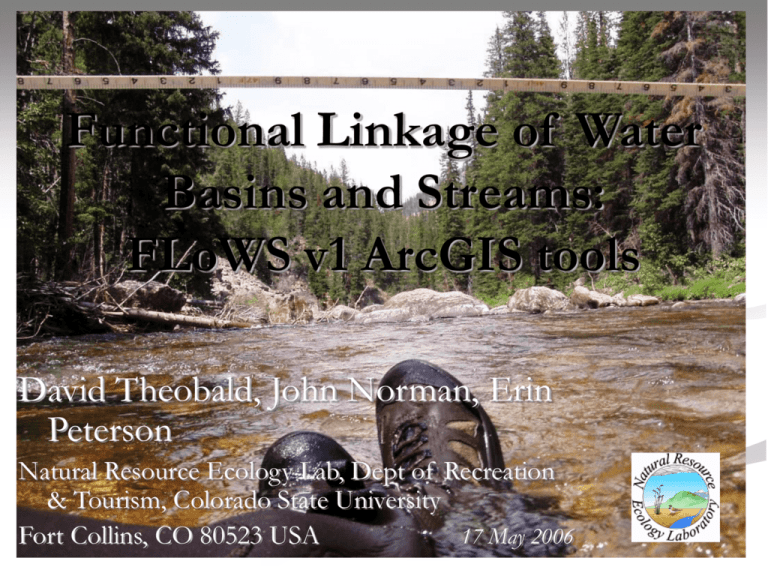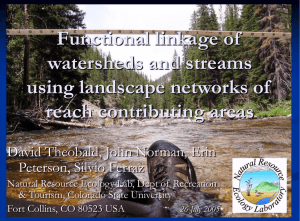Functional Linkage of Water basins and Streams: FLoWS v1 ArcGIS
advertisement

Functional Linkage of Water Basins and Streams: FLoWS v1 ArcGIS tools David Theobald, John Norman, Erin Peterson Natural Resource Ecology Lab, Dept of Recreation & Tourism, Colorado State University Fort Collins, CO 80523 USA 17 May 2006 Project context Challenges of STARMAP (EPA STAR): Addressing science needs Clean Water Act Integrate science with states/tribes needs Develop landscape-based indicators to assist in testing tenable hypotheses generated using understanding of ecological processes Premise Challenges to develop improved landscape-scale indicators (Fausch et al. 2002; Gergel et al. 2002; Allan 2004) are: - clearer representation of watersheds & hierarchical relationship; - incorporate nonlinearities of condition among different watersheds and along a stream segment Need to characterize spatial heterogeneity & scaling of watersheds when developing indicators of biological condition Goal: to develop indicators that more closely represent our understanding of how ecological processes are operating From watersheds/catchments as hierarchical, overlapping regions… River continuum concept (Vannote et al. 1980) “Lumped” or watershed-based analyses % agricultural, % urban (e.g., ATtILA) Average road density (Bolstad and Swank) Dam density (Moyle and Randall 1998) Road length w/in riparian zone (Arya 1999) But ~45% of HUCs are not watersheds EPA. 1997. An ecological assessment of the US Mid-Atlantic Region: A landscape atlas. EPA ATtILA 2002. … to network of catchments Network Dynamics Hypothesis - Benda et al. BioScience 2004 Reaches linked to catchments 1 to 1 relationship Properties of the watershed can be linked to network for accumulation operation Covariates: landscape context 1. Co-variate(s) at spatial location, site context - E.g., geology, elevation, population density at a point 2. Co-variate(s) within some distance of a location - Housing density at multiple scales 3. Watershed-based variables - Proportion of urbanized area 4. Spatial relationships between locations - Euclidean (as the crow flies) distance between points - Euclidean (as the fish swims) hydrologic network distance between points 5. Functional interaction between locations - Directed process (flow direction), anisotropic, multiple scales - How to develop spatial weights matrix? - Not symmetric, stationary violate traditional geostatistical assumptions!? Local vs. accumulated (e.g., Human Urban Index) Local Accumulated Accumulated USGS NHD, NED USGS NHD, NED Pre-processing Generating reach contributing areas (RCAs) Automated delineation Inputs: stream network (from USGS NHD or other) topography (USGS NED, 30 m) Processes: 1. traditional WATERSHED command requires FILLed DEM – “hydro-conditioned” 2. Cost-distance using Topographic Wetness & Position Indices “true” “adjoint” catchments catchments Segments Generating RCAs: FILLed 1.) Filled DEM 2.) Flow Direction Artifacts? Generating RCAs: cost-distance 1.) DEM 2.) Topographic Wetness Index 3.) Topographic Position Index Generating RCAs 4) Stream Reaches 5.) RCAs (Yellow) Evaluation of RCAs “Truth” Hand-delineated from 1:24K Modeled (1:100K, 30 m DEM): A. traditional (FILL-ing) B. cost-distance Measure: Jaccard’s similarity coefficient: b / (a + b + c) a b c Preliminary results FILLed DEM 50 m/WATERSHED Mean accuracy: 78% Cost-distance RCAs Mean accuracy: 85% Within RCA hydro-weighting Overland flow (hydro distance to stream) Instream flow (hydro network distance to outlet) Landscape Network Landscape network features and associated relationships table From graph theory perspective, reaches are nodes, confluences are edges Network connectivity errors Selections User-defined field Polylines or RCAs Cumulative (distance from selected feature) Analysis Estimated discharge Average annual precipitation & temperature, basin area Vogel et al. 1999 Vogel Analysis Export to distance matrices Straight-line Instream distance Distance matrices (cont.) Downstream only Upstream only Distance matrices (cont.) Proportion upstream Proportion downstream Distance matrices (cont.) Downstream portion dist only Number of confluences Example: Coho salmon distances Summary River Continuum to Network Open Simple data structure Python linked to GeoProcessing object Non-GIS (thru Access, SQL, etc.) Flexible From overlapping waterbasins to network spatial structure User-defined variables to accumulate, navigate network Different selection sets, combinations Compute framework once, use with many point configurations (samples) Robust Flow-based vs. Strahler stream order Cost-weighted methods Developed, tested (broken), refined E.g, Mid-Atlantic Highlands; Oregon; Central Shortgrass Prairie; Alaska; Next steps Project/tool website: www.nrel.colostate.edu/projects/starmap FLoWS database to complement tools Attach additional attributes to FLoWS database FLoWS, FunConn, RRQRR Land cover (urban, ag, “natural”) Historical, current, future housing density Hydro & slope weighted road density Human accessibility Within reach/segment Streams as 2D features SCALE: Grain Terrestrial Aquatic Landscape River Network COARSE Climate Atmospheric deposition Geology Topography Soil Type Network Connectivity Nested Watersheds Land Use Topography Stream Network Connectivity Drainage Density Flow Direction Confluence Density Network Configuration Vegetation Type Basin Shape/Size Segment Contributing Area Segment Tributary Size Differences Network Geometry Localized Disturbances Land Use/ Land Cover Reach Riparian Zone Riparian Vegetation Type & Condition Floodplain / Valley Floor Width Microhabitat Cross Sectional Area Channel Slope, Bed Materials Large Woody Debris Substrate FINE Shading Detritus Inputs Peterson 2005 Overhanging Vegetation Biotic Condition Microhabitat Biotic Condition, Substrate Type, Overlapping Vegetation Detritus, Macrophytes Example: 2D stream in Virginia Example: 2D stream in Virginia Example: 2D stream in Virginia Example: 2D stream in Virginia Thanks! Comments? Questions? Thanks to K. Verdin at USGS EROS Data Center for sharing EDNA datasets Funding/Disclaimer: The work reported here was developed under the STAR Research Assistance Agreement CR-829095 awarded by the U.S. Environmental Protection Agency (EPA) to Colorado State University. This presentation has not been formally reviewed by EPA. The views expressed here are solely those of the presenter and STARMAP, the Program (s)he represents. EPA does not endorse any products or commercial services mentioned in this presentation. FLoWS: www.nrel.colostate.edu/projects/starmap davet@nrel.colostate.edu CR - 829095 Zonal Accumulate Process/Functional Up/down (net.) Water basin - Stream Hydrologic distance: -Instream -Up vs. down? FLoWS Overlapping watersheds Accumulate downstream FLoWS (and SPARROW) Stand-alone watershed Watershed-based analyses (HUCs) Tesselation of true, adjoint catchments ? Watershed HUCs/WBD Reach Contributing Areas (RCAs) Grain (Resolution)











